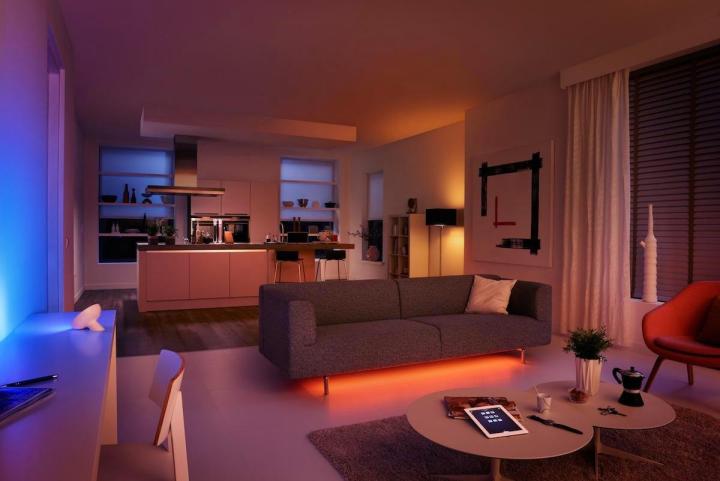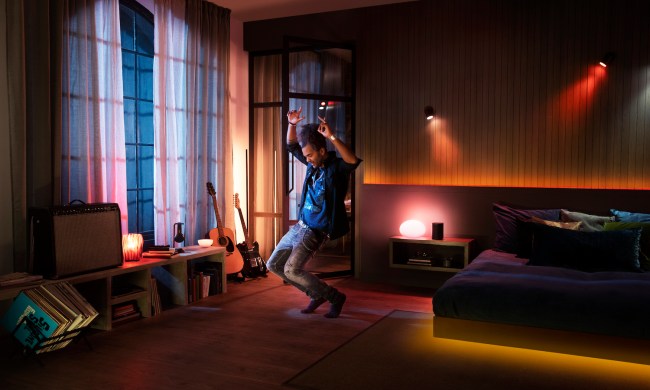
Earlier this month, Philips unveiled two new smart lighting accessories to expand the Hue ecosystem. The LivingColors Bloom ($80) and LightStrips ($90), part of the Friends of Hue line, take the concept of a smart lightbulb and apply it in different shapes and forms so you can class up any living space regardless of an available light socket. Here’s a run down of how the system works.
Look and feel
The two accessories have different form factors that serve different purposes. The LightStrips are made of soft, flexible silicone, and you can see the intricacies of the bulb and wiring through the clear gel body. It comes nicely wound up in a reel, and the entire length of the strip measures two meters, or just over six-and-a-half feet.
… accent the room in places that don’t have light sockets, and still control everything straight from a mobile app.
The back of the strip comes with a 3M pad to stick it around a surface. You can wrap the lights around windows and picture frames, or use them to outline and define other features in a room. It’s sort of like ground effects for inanimate objects instead of cars. Unlike the original Hue, the wireless chip is not installed within the bulb itself, but through a receiver that’s connected to its power cord.
The Bloom, on the other hand, is a heavier device thanks to its white metal body and ceramic glass cover. The device measures four inches in diameter. It’s got a wide surface area, allowing for feature lighting in spaces or walls where there are no overhead bulbs.
With a 120-lumen LED bulb, the Bloom serves as a way to accent large areas of the room, though it is certainly as not bright as the original Hue’s 600 lumens output. There are also no screws or bolts to mount it, so your only option is to leave it on a floor or table. The Bloom does come with its own remote control to adjust colors and brightness without Internet connectivity.
Unlike the original Hue bulbs, these devices both need to be plugged into a wall for power, so there’s the cord to consider when placing either accessory.
Setting up
Just like the initial setup for the Hue LED bulbs, all you have to do is plug the Bloom and/or LightStrips in, fire up the Hue app, and search for the devices on your network. Add them to your room’s set up and you’re good to go. Now, you are able to turn the lights on or off, change the colors and brightness, and schedule timer settings for each device straight from the app.
Both the Bloom and LightStrips are compatible with third party APIs, such as IFTTT and Belkin WeMo, to help program the lights to react during specific events. For more ideas on how you can put these recipes to use, check out our full Hue review.
Lights, more lights, action!
Both the Bloom and LightStrips blend into the Hue ecosystem seamlessly and add pops of color in areas that are otherwise neglected. We also found the LightStrips to be perfect night lights, softly illuminating a room without the brightness of normal Hue bulbs, and easily turned on and when needed. If you have IFTTT and WeMo set up, you could even automate things like turning just the LightStrips on when the sensor recognizes you walking into the room between the hours of midnight to 5 a.m.

Once added to the Hue app, these accessories also become automatically integrated for preset light scenes. This means you don’t have to select the specific color for the LightStrips or Bloom to ensure they match the “Deep Sea” setting – though you can do so if you’re so inclined. Like the original Hue, you can also take a photo and use the colors from that image as a theme to accent the room.
This is weird

With the Bloom, our only issue is how hot it gets after a couple of minutes of use. Though it is advertised as portable, you probably shouldn’t touch and move this around soon after it’s shut off – metal is a highly effective heat conductor, because of science.
Should you buy it?
Overall, we were impressed with how much of a difference the LightStrips and Bloom added to the Hue ecosystem. It’s nice to be able to accent the room in places that don’t have light sockets, and still control everything straight from a mobile app. Unfortunately, you will need the original Hue starter kit ($200) if you want to use either of the accessories with the Hue app, since the LightStrips and Bloom come without a bridge base station. Technically, you can just plug the LightStrips into a wall, but there’s no way to access all the functionality that makes it a Hue. The Bloom can work with just the remote control if you don’t have a base station, but the functionality of the app is considerably more robust than the remote, which can’t access the same level of color gradients. If Philips sold each with the Wi-Fi chip built into the product, we would wholeheartedly recommend either.
If you already have Hue and are looking to expand its reach beyond your light sockets – and you don’t mind the price – go wild. The LightStrips and Bloom will keep up.




